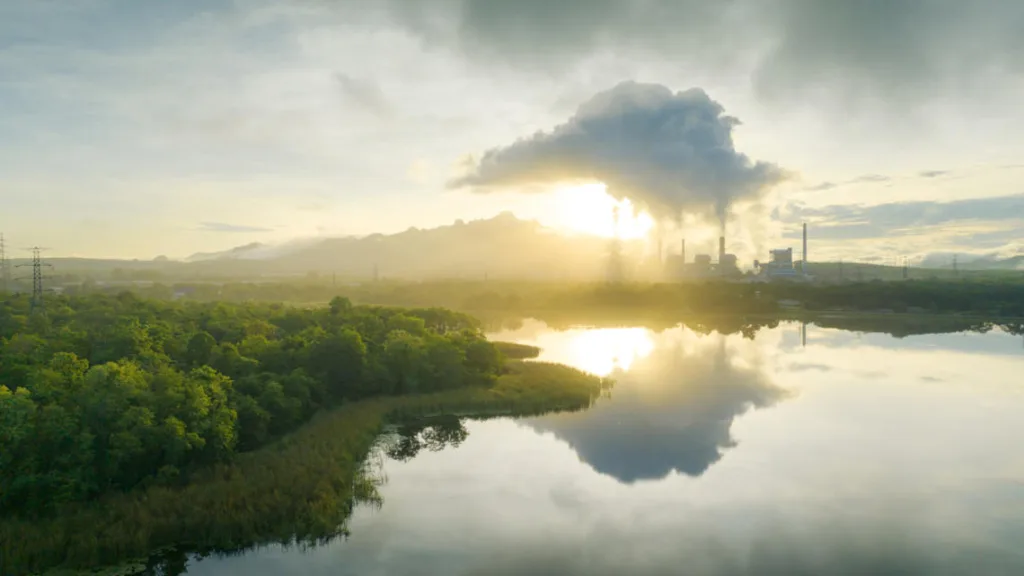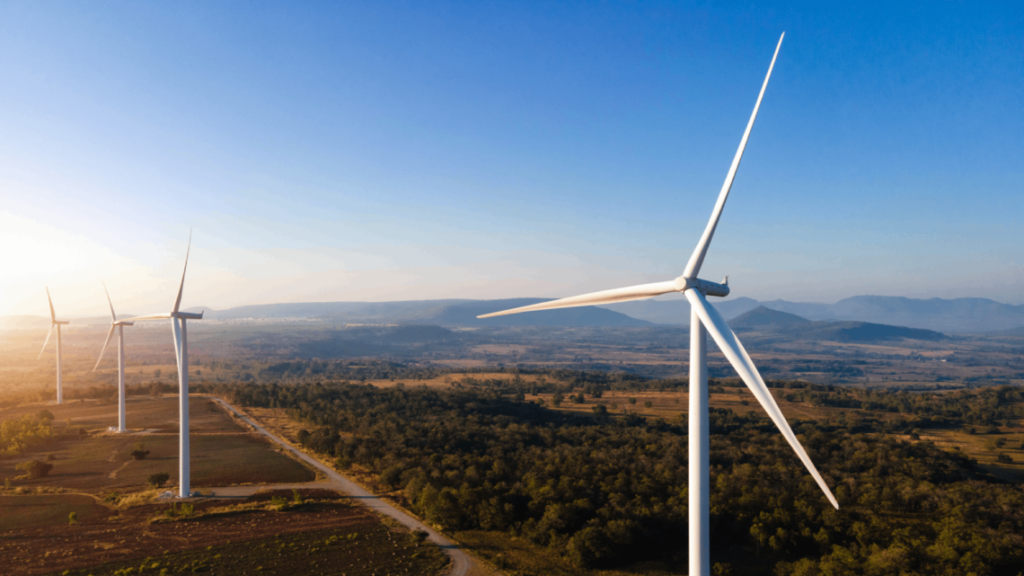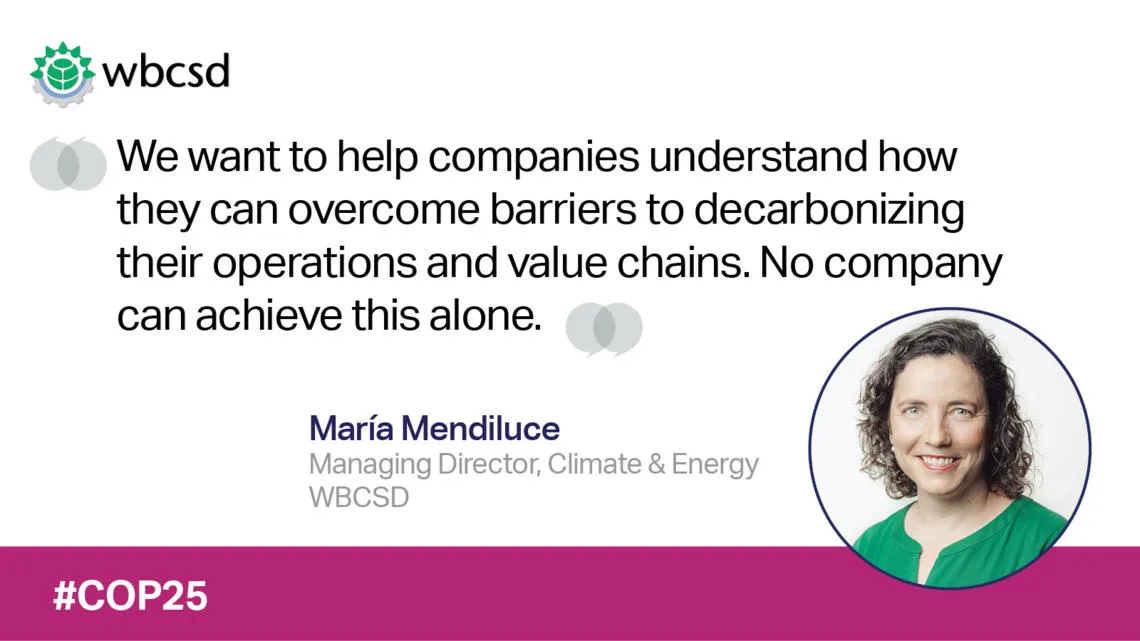Authors
Maria Mendiluce
As we follow the global climate talks in Madrid this week, there has never been more at stake. The UN Environment Programme’s latest Emissions Gap report published last week puts new figures on a well-known fact: Our ‘business as usual’ model is hurtling us closer to dangerous climate change. As the 2020 deadline looms for governments around the world to reveal their climate action plans, there is no time to lose.
How can we transform systems across the global economy to ensure that in 2050 more than nine billion people can live well within the limits of our planet? We must see raised ambition across businesses and governments to scale up climate action towards a carbon neutral economy.
Businesses are key to driving this change across geographies, sectors and value chains. As Managing Director for Climate & Energy, Cities & Mobility and Circular Economy, Maria Mendiluce helps guide more than 200 of WBCSD’s member companies towards systems transformation and meaningful climate action. Our programs and projects help bring businesses across the entire journey of transformation: from identifying climate risks and setting science-based targets, to re-thinking their energy and investment strategies, investing in natural climate solutions, and calling for the right policies to accelerate action.
Maria, can you tell about WBCSD’s new vision for climate and energy?
2020 is the “super year” for climate and many more sustainability-related ambitions including food, nature and the SDGs in general. It will be a defining year if we want to save our planet.
The IPCC report published in October 2018 has confirmed that every fraction of warming matters. We must do all we can to limit the temperature increase to 1.5°C to avoid the risk of irreversible damage to ecosystems as well as people’s health and livelihoods.
This IPCC report shows that we need to reduce greenhouse gas (GHG) emissions by 50% every decade from now until 2050 – moving from the current 54 GT annual GHG emissions to around 7 GT in 2050. This will mean massive transformation across the global economy and require radical collaboration.
Science also shows that the next decade will be crucial if we are to have any chance of getting there. Hence the importance of 2020: the year when countries need to update their Nationally Determined Contributions (NDCs) and long-term strategies to align with the latest science and net-zero emissions. The EU is moving in that direction and many more countries must join with the same purpose and determination.
Around the world, governments, civil society and businesses are fighting against business as usual and pledging action to reduce emissions aligned with 1.5ºC scenarios. But we need to go faster and further.
WBCSD is launching a new climate action initiative to fulfill our vision of net-zero emissions by 2050 called SOS 1.5. We want to help companies understand how they can overcome barriers to decarbonizing their operations and value chains. No company can achieve this alone. Our new Safe Operating Space (SOS) 1.5 strategy for businesses helps companies work together to transform markets and products to propel a global, low-carbon transition. SOS1.5 provides a framework for companies to understand their climate risks and opportunities, but also set science-based targets to put climate action at the heart of their decision-making.
How do you see the role of business in climate action evolving?
Business is vital to achieving systems transformation at the scale needed to avoid dangerous climate change. And they know it. In the same way that countries are ratcheting their ambition aligned with the latest science, business is stepping up.
Over 700 companies have committed to science-based targets to meet the Paris Agreements goals. Close to 100 companies have committed to becoming carbon neutral by 2050, by lowering their emissions with enough ambition to meet the 1.5ºC scenarios. Next week at COP 25 in Madrid, we will see more companies joining this movement.
We need many more companies to commit to these initiatives if we are to move beyond ambition to implementation. And companies should know that the transition is underway. Even if they don’t commit to net-zero plans, they will need to reduce their emissions to be preferred providers to large multinationals. For example, car manufacturers have announced ambitious decarbonization plans that will require their supply chains to provide zero or low-carbon products (power, plastic, steel, aluminum, etc.). IT companies have signed up to 100% renewable targets including their supply chains, which obliges their providers to step up as well.
In 2020 we must see more companies integrating climate action into their company strategies. From corporate strategy, investment plans and procurement, to marketing and skills development, we need to drive climate action across all business operations.
The investment community needs to understand companies’ exposure to climate risks and opportunities, which will lead to better valuation and cost of capital for climate-proofed companies. But more importantly, companies need to communicate their climate activities in their engagement with employees, consumers and communities where they operate. By doing this, consumers, employees and financiers will be able to choose a company based on its climate credentials.
Integrating climate action into company strategy and communications will make companies more sustainable and more successful.
Is business truly moving towards the direction of net-zero emissions? What examples do you see of this?
Across all sectors, businesses are innovating with new technologies and business models to align their operations with net-zero ambition.
In the car industry, Volkswagen has pledged USD $30 billion to expand its electromobility, while Daimler has pledged to sell only carbon neutral cars by 2039. Across other sectors, major global companies such as Gucci, Nestle, Ikea and many others have committed to transitioning their operations and value chains to net-zero emissions by no later than 2050.
So business is indeed moving, but we need many more to power our transition at the speed we need.
What do you think is stopping companies from moving to net zero?
Transforming a company to have zero impact in terms of GHG emissions is not easy. For many sectors this is not achievable without using natural climate solutions to offset their emissions. These are activities which restore, conserve or scale-up forest’s and other ecosystems potential to store carbon from the atmosphere through reforestation and preserving grasslands and wetlands. To set a net-zero commitment requires courage. We don’t yet hold all the answers to transform our systems but CEOs are stepping up and steering the direction of travel so that their employees, providers and customers can embrace the challenge and align their actions with that direction. And we know that once these companies have set targets and plans to decarbonize, they can often achieve these ahead of time because everybody in the company in pushing in one direction, creating opportunities that were not envisaged before.
If we look at the four main levers of emissions today – energy, transport, materials and land – we see that most of the emissions reductions can be done with existing and profitable solutions. Companies can now shift to renewable energy as the main source of electricity and can electrify most energy uses except high temperature heat. Companies can transport goods and people using electricity for most of their trips, except for airplane and long-distance shipping. Hence, in the short-term companies can start with what is available and for the midterm, we need to find alternative solutions to produce materials that require high temperature heat and figure out how we can move air transportation to clean technologies.
The existence of technologies doesn’t mean that it is easy to implement them. Through SOS1.5, WBCSD will identify the main blockers – lack of demand, inappropriate regulation, consumer behavior, bankability of projects and technology readiness – and provide solutions to address them, which will center around stronger collaboration between business and governments.
What would you like to see by 2050? And how can companies get us there?
Personally, I hope that by 2050 the world will have advanced to solve these planetary challenges, and the children of our children will live in a world where emissions and waste have no place, people have access to equal opportunities, and nature is restored to a fundamental part of our economies.
WBCSD news articles and insights may be republished in accordance with the Creative Commons Attribution-NonCommercial-NoDerivatives 4.0 International Public License, and in accordance with our Privacy Policy. All Content must be featured with due credits.
Related
Content

Renewable electricity procurement: blazing a trail from innovation to leadership
27 April, 2023

Carbon removals: Why a portfolio approach is key to achieving climate goals
19 April, 2023

WBCSD updates the climate scenario analysis tool for companies to leverage in their climate-related financial disclosures
31 March, 2023

